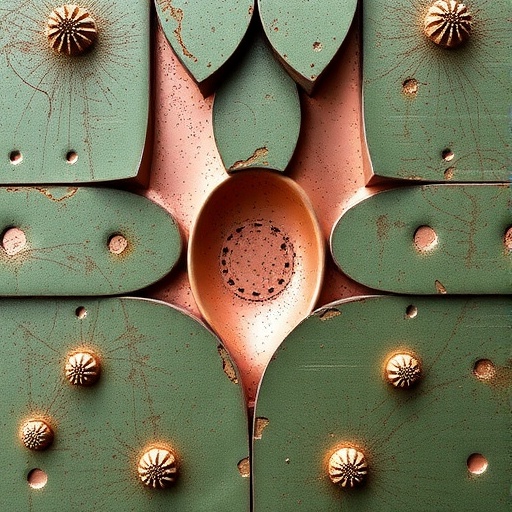In a remarkable convergence of biology and materials science, researchers have unveiled an innovative approach to improve copper intrauterine devices (IUDs), devices widely regarded for their effectiveness and affordability in long-term contraception. Despite their popularity, copper IUDs have long been associated with initial side effects such as menstrual irregularities and pelvic discomfort, largely due to the chemical reactions that occur once the device is implanted into the uterine environment. Now, inspired by the natural world, scientists have developed a surface modification for copper IUDs that promises to mitigate these adverse effects by mimicking the microstructural features of a common houseplant’s leaf.
Copper IUDs function through the release of copper ions, which create an inflammatory environment hostile to sperm and thus prevent fertilization. However, the initial months following insertion often involve a pronounced “burst release” of copper ions. This phenomenon occurs because copper reacts chemically with uterine fluids, leading to corrosion of the device’s surface and enhanced ion liberation. This intense release can provoke symptoms including heavier menstrual bleeding, increased cramping, and even pelvic inflammatory disease. These side effects diminish compliance and deter some individuals from opting for these otherwise cost-effective contraceptives.
The breakthrough, published in the leading interdisciplinary journal Biointerphases, reveals that the researchers from Changchun University and Northeast Normal University have honed in on a remarkable biological model for their solution: the golden pothos plant (Epipremnum aureum). Known for its hydrophobic leaf surface, this plant exhibits microstructures that cause water droplets to bead and effortlessly roll off. Such properties reduce moisture retention and prevent damage from prolonged water contact. With this natural mechanism as their blueprint, the research team embarked on engineering a similarly textured surface for the copper IUD.
Scanning electron microscopy revealed that the golden pothos leaf possesses a complex topography characterized by interconnected ridges and hexagonal valleys. These intricate patterns generate a protective barrier that repels water by dramatically reducing the contact area between the liquid and the leaf surface. The scientists meticulously quantified this morphology by measuring ridge diameters, valley depths, and angular orientations, providing precise parameters for replicating the surface at a microscopic scale.
To translate these biological insights into a practical application, the team employed femtosecond laser texturing—a highly precise, ultrafast laser technology capable of inscribing microscopic patterns onto metal surfaces without compromising bulk integrity. By engraving the bioinspired pattern onto copper discs analogous to IUDs, the researchers produced surfaces that exhibited markedly enhanced hydrophobicity. This advancement reduces the adhesion and corrosion effects caused by uterine fluid, directly targeting the primary cause of copper ion burst release in existing devices.
Extensive laboratory testing confirmed the efficacy of the modified surfaces. In corrosion simulations using synthetic uterine fluid, the patterned copper surfaces demonstrated a significantly slower rate of degradation compared to traditional flat copper. Correspondingly, ion release assessments revealed a pronounced decrease in copper ion dispersion, indicating the potential for fewer side effects when used in vivo. Beyond chemical stability, cellular assays assessing cytotoxicity and viability substantiated that the bioinspired IUD surfaces were more biocompatible, causing reduced cellular damage and promoting healthier tissue interactions.
This fusion of biomimicry with precision laser engineering represents not only an incremental improvement but a paradigm shift in contraceptive device design. Unlike alternative strategies that rely on polymer coatings or alloying metals—which can introduce additional complications such as coating degradation or alloy supply chain vulnerabilities—this method is inherently scalable and relies solely on surface topology modifications of pure copper. Such a technique ensures manufacturing consistency, robustness, and long-term device performance.
The researchers emphasize that this innovation stands as a vivid example of how insights gleaned from natural microarchitectures can drive health-centered technological advancements. By bridging the interdisciplinary realms of physics, chemistry, and biology, this work paves the way for future developments in women’s health technology, offering a safer, more comfortable contraceptive option accessible to millions worldwide.
Looking forward, the team plans to refine their laser texturing processes for mass production scalability, ensuring uniformity and cost-effectiveness. Crucially, they are preparing for in vivo studies that will test the long-term behavior and safety profile of the bioinspired copper IUDs within living organisms, a vital step towards clinical application and regulatory approval.
Junbo Liu, the lead author, remarked on the broader significance of their work, underscoring how surface engineering informed by natural models can revolutionize biomedical device design, improve user experience, and reduce adverse effects— a tangible melding of nature’s wisdom with modern technology.
This research opens a new frontier in contraceptive innovation, highlighting how addressing the micro-scale interface between device and biological environment can yield macroscopic benefits in health outcomes. With continued development, laser-textured copper IUDs promise to redefine standards in contraceptive safety, efficacy, and patient comfort across the globe.
Subject of Research:
Copper intrauterine device surface modification inspired by the microstructures of the golden pothos plant leaf for improved hydrophobicity and reduced corrosion.
Article Title:
A femtosecond laser-textured copper surface for reducing initial copper ion burst release in intrauterine devices
News Publication Date:
28-Oct-2025
Web References:
https://doi.org/10.1116/6.0004923
Image Credits:
A golden pothos plant (Epipremnum aureum) and scanning electron microscope images of its surface microstructures. Credit: Liu et al.
Keywords:
Birth control, Human health, Physics, Hydrophobicity, Corrosion resistance




